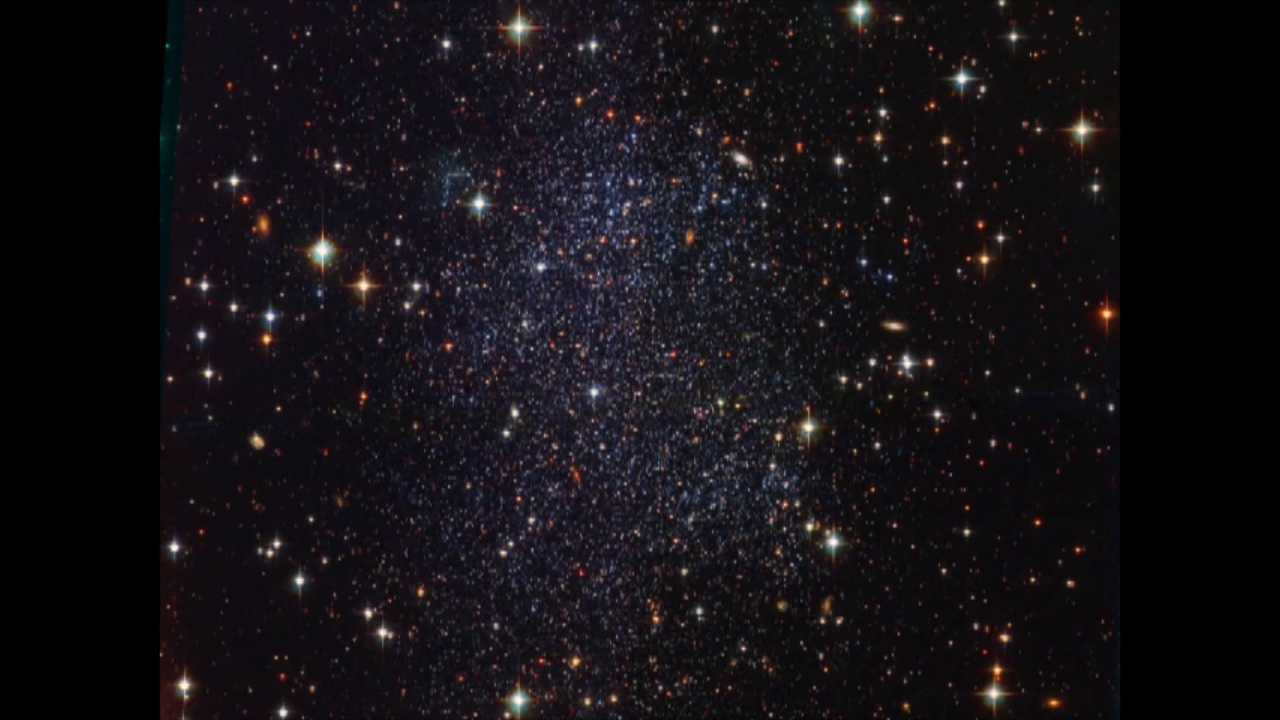1 min read
Reddish Arcs Mark Trail of Small Asteroid

While analyzing NASA Hubble Space Telescope images of the Sagittarius dwarf irregular galaxy (SagDIG), an international team of astronomers led by Simone Marchi, Yazan Momany, and Luigi Bedin were surprised to see the trail of a faint asteroid that had drifted across the field of view during the exposures. The trail is seen as a series of 13 reddish arcs on the right in this August 2003 Advanced Camera for Surveys image.
As the Hubble telescope orbits around the Earth, and the Earth moves around the Sun, a nearby asteroid in our solar system will appear to move with respect to the vastly more distant background stars, due to an effect called parallax. It is somewhat similar to the effect you see from a moving car, in which trees by the side of the road appear to be moving much more rapidly than background objects at much larger distances. If the Hubble exposure were a continuous one, the asteroid trail would appear like a continuous wavy line. However, the exposure with Hubble's camera was actually broken up into more than a dozen separate exposures. After each exposure, the camera's shutter was closed while the image was transferred from the electronic detector into the camera's computer memory; this accounts for the many interruptions in the asteroid's trail.
Since the trajectory of the Hubble spacecraft around the Earth is known very accurately, it is possible to triangulate the distance to the asteroid in a manner similar to that used by terrestrial surveyors. It turns out to be a previously unknown asteroid, located 169 million miles from Earth at the time of observation. The distance places the new object, most likely, in the main asteroid belt, lying between the orbits of Mars and Jupiter. Based on the observed brightness of the asteroid, the astronomers estimate that it has a diameter of about 1.5 miles.
The brightest stars in the picture (easily distinguished by the spikes radiating from their images, produced by optical effects within the telescope), are foreground stars lying within our own Milky Way galaxy. Their distances from Earth are typically a few thousand light-years. The faint, bluish SagDIG stars lie at about 3.5 million light-years (1.1 Megaparsecs) from us. Lastly, background galaxies (reddish/brown extended objects with spiral arms and halos) are located even further beyond SagDIG at several tens of millions parsecs away. There is thus a vast range of distances among the objects visible in this photo, ranging from about 169 million miles for the asteroid, up to many quadrillions of miles for the faint, small galaxies.
The team reported their science findings about the asteroid in the October 2004 issue of New Astronomy.
About the Object
- R.A. PositionR.A. PositionRight ascension – analogous to longitude – is one component of an object's position.19h 29m 59s
- Dec. PositionDec. PositionDeclination – analogous to latitude – is one component of an object's position.-17° 40' 00"
- ConstellationConstellationOne of 88 recognized regions of the celestial sphere in which the object appears.Sagittarius
- DistanceDistanceThe physical distance from Earth to the astronomical object. Distances within our solar system are usually measured in Astronomical Units (AU). Distances between stars are usually measured in light-years. Interstellar distances can also be measured in parsecs.Distance to Galaxy: 3.5 million light-years (1.1 Megaparsecs); Distance to Asteroid: 169 million miles (1.82 Astronomical Units)
- DimensionsDimensionsThe physical size of the object or the apparent angle it subtends on the sky.This image is 1.5 arcminutes wide. At the distance to the galaxy, this represents a physical dimension of 1,500 light-years (470 parsecs). At the distance of the asteroid, this represents a physical dimension of 72,000 miles (116,000 kilometers).
About the Data
- Data DescriptionData DescriptionProposal: A description of the observations, their scientific justification, and the links to the data available in the science archive.
Science Team: The astronomers who planned the observations and analyzed the data. "PI" refers to the Principal Investigator.The Hubble image was created from HST data from proposal 9820: Y. Momany and L. Bedin (Univ. of Padua), E. Held (Astr. Obs. of Padua), K. Kuijken (Univ. of Leiden), R. Rich (UCLA), L. Rizzi (Univ. of Padua), and I. Saviane (ESO – Chile). The science team involved with the asteroid is: S. Marchi, Y. Momany, and L. Bedin (Univ. of Padua). - InstrumentInstrumentThe science instrument used to produce the data.HST>ACS/WFC
- Exposure DatesExposure DatesThe date(s) that the telescope made its observations and the total exposure time.August 18, 2003
- FiltersFiltersThe camera filters that were used in the science observations.F435W (B), F606W (V), F814W (I)
- Object NameObject NameA name or catalog number that astronomers use to identify an astronomical object.Asteroid Trail in Sagittarius Dwarf Irregular Galaxy, SagDIG, ESO 594-4
- Object DescriptionObject DescriptionThe type of astronomical object.Serendipitous Asteroid Trail in Field
- Release DateNovember 11, 2004
- Science ReleaseHubble Tracks Asteroid’s Sky Trek
- Credit

Blue: F435W (B) Green: F606W (V) Red: F814W (I)

Related Images & Videos

Sagittarius Dwarf Galaxy
This new image from the Hubble Space Telescope shows a small galaxy called the Sagittarius dwarf irregular galaxy, or "SagDIG" for short. SagDIG is relatively nearby, and Hubble's sharp vision is able to reveal many thousands of individual stars within the galaxy. The brightest...
Share
Details
Claire Andreoli
NASA’s Goddard Space Flight Center
Greenbelt, Maryland
claire.andreoli@nasa.gov





























